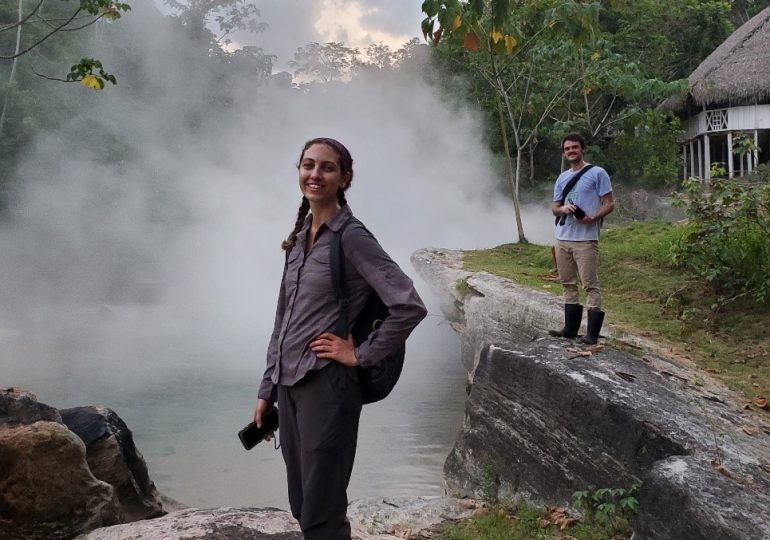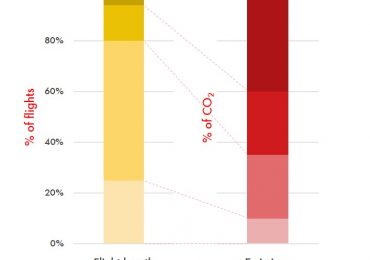In our last post Alyssa Kullberg, postdoc at WSL in Lausanne, presents her work ‘Seasonal acclimation of photosynthetic thermal tolerances in six woody tropical species along a thermal gradient’. Here, she discusses the need to study warming, shows her incredible experimental system and shares her road in ecology from her early concerns about climate change.
A Spanish Translation of this blog post is available here.
About the research
Tropical plants may be particularly vulnerable to higher temperatures associated with climate change because they have evolved under relatively stable and aseasonal conditions. Studying the vulnerability of tropical plants to high temperatures is challenging, especially in the lowlands, where there is simply no current analogue of the future hotter climate, and where artificial warming experiments are expensive and difficult to set up.
Overcoming these issues, we used a thermal gradient in the lowland Amazon rainforest formed by a natural geothermal river – the Boiling River – to study plant responses to different growing temperatures along the thermal gradient. The hot steam emanating from the Boiling River, which reaches 98 °C at its hottest point, warms the air in the riparian forest along the river, creating a difference in mean annual air temperature of 4 °C and a difference in maximum air temperature of 11 °C over a distance of just 0.5 km! In other words, the Boiling River acts as a ‘natural experiment’ to test how plants respond in situ to high temperatures that are not currently observed in other moist areas of the lowland Amazon.
With this design, we studied how the physiology of the plants growing along the river acclimates to different growing temperatures. Given the fast rate of anthropogenic climate change, long-lived taxa with long generation times such as most woody species will have to rely primarily on their abilities to acclimate (i.e., phenotypic plasticity) rather than adapt to higher temperatures, which is what the Boiling River allows us to study.
About the paper
In this study, we looked at how the physiology of the plants acclimates along the temperature gradient as well as between seasons. The objectives of the seasonal comparison were to uncover whether they acclimate on short (intra-annual) timescales, whether the magnitude of their acclimation depends on the seasonal temperature change (which is greater in hotter areas of the thermal gradient), and lastly to infer relationships between leaf and air temperatures. Specifically, we looked at the photosynthetic thermal tolerance – the leaf temperature causing permanent damage to the photosynthetic machinery – in six woody plant species that grow commonly across the thermal gradient. Our study is one of just a handful to measure thermal tolerances in tropical plants and the first to investigate seasonal acclimation of thermal tolerance in the moist Amazon rainforest.
We found that three out of the six plant species that we sampled acclimated between seasons by increasing their thermal tolerances at the end of the hotter dry season. For a different set of three species, we found that the magnitude of acclimation between seasons was larger at microsites where seasonal temperature differences were greater. In other words, the greater the temperature increase between seasons, the greater the response in thermal tolerance for three species, suggesting that these species are more sensitive to changes in air temperature and perhaps that leaf and air temperatures are closely correlated. Overall, seasonal acclimation is indicative of more sensitive species to high temperatures and is likely insufficient to overcome thermal stress during increasingly frequent high temperature events. That said, there was evidence that trees growing at hotter temperatures were capable of acclimating better regardless of the seasonal temperature change.
Some of the biggest challenges we faced with this study were the logistical complications at the Boiling River. For example, to measure thermal tolerance, leaves must be heated in water baths to temperatures ranging from room temperature to nearly 70 °C, which typically requires specialized equipment to heat water to specific temperatures, not to mention a lot of electricity. Given that there was no electricity onsite and no nearby facilities, we had to come up with a creative solution to heat our leaves. Our solution was to use hot water from a hot pool of the Boiling River, mixed in differing amounts with room-temperature water to create the desired range of water temperatures. And instead of using a thermostatic mixer to maintain constant water temperatures during the treatments, we used vacuum-insulated water bottles – the same kind that you would use to store a cold refreshment on a hot day.
There are still many questions left to study at the Boiling River, such as the effects of hotter growing temperatures on net photosynthesis and respiration and associations with microbial symbionts. Our team is also working to uncover how the plant community as a whole is impacted by elevated temperatures along the gradient.
About the author
Since I was little, I have been concerned about the ways that anthropogenic climate change is reshaping our planet. Combined with my love of nature and spending time outdoors, it was obvious that I would study ecology and the environment when I went off to college. My interest in tropical plants came later, when I spent a semester studying ecology and conservation in Ecuador and fell in love with the diversity and beauty of tropical forests. I also started my career as a plant ecologist in Ecuador after I graduated college, where I spent a year studying rare magnolia trees in the cloud forest. I recently completed my PhD at the University of Miami, where I refocused my research on tropical plants toward acclimation to elevated growing temperatures and conducted research in Miami (Florida, USA), Peru, and Colombia. This paper represents work I did alongside my dissertation research. Currently, I’m a postdoc with the Plant Ecology Research Lab (PERL) at EPFL in Switzerland, continuing to investigate the effects of elevated growing temperatures and also drought on tree acclimation.
Like the blog post? Read the research here.
Leave a comment







